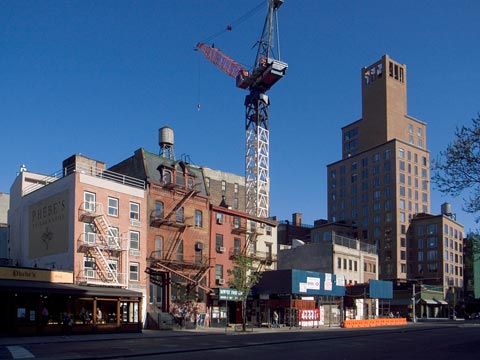New photographs of the Lower East Side. I continue to work on this never-ending project, still looking for a venue for showing this–I think–extraordinary encapsulation of New York history. It is important for any number of reasons, not the least of which is that the Lower East Side is America’s quintessential immigrant neighborhood, a portal through which millions of people can trace their ancestry and arrival in the United States. It is now undergoing fundamental change, reflecting the rapid transformation of the city since 9/11.
I did a few new pictures of the Bowery/Third Avenue north of Houston Street adjacent to the East Village. There are numerous buildings new or under construction along this stretch. At the Bowery and East 4th Street I did a wide shot of a group of low structures–some quite old–with the ultra chic Bowery Hotel towering above. A crane stands in a small vacant lot suggesting a very tall, thin, building to come.
Although there are some in the neighborhood who see the Bowery Hotel as out-of-scale–it replaces a grungy gas station that stood there for more than 25 years–it also replaces an earlier out-of-scale bank building. Across East 3rd is a Salvation Army shelter that once housed Jack Abbott, the writer of In the Belly of the Beast, a book about prison life championed by Norman Mailer. Here’s a bit from Wikipedia:
In 1965, aged twenty-one, Jack Abbott was serving a sentence for forgery in a Utah prison when he stabbed a fellow inmate to death. He was given a sentence of three to twenty years for this offense, and in 1971 his sentence was increased by a further nineteen years after he escaped and committed a bank robbery in Colorado. Behind bars he was troublesome and often refused to obey guards’ orders. He spent a great deal of time in solitary confinement.
In 1977 he read that author Norman Mailer was writing about convicted killer Gary Gilmore. Abbott wrote to Mailer and offered to write about his time behind bars and the conditions he was experiencing. Mailer agreed and helped to publish In the Belly of the Beast, a book on life in the prison system consisting of Abbott’s letters to Mailer.
Mailer supported Abbott’s attempts to gain parole. Susan Sarandon’s son, Jack Henry Robbins, is named after Abbott. Abbott was released on parole in June 1981. He went to New York City and was the toast of the literary scene for a short while.
On the morning of July 18 (1981), just six weeks after getting out of prison, Jack Abbott went to a small cafe called the Binibon in Manhattan. He clashed with 22-year-old Richard Adan, son-in-law of the restaurant’s owner, over Adan’s telling him the restroom was for staff only. The short-tempered Abbott stabbed Adan in the chest, killing him. The very next day, unaware of Abbott’s crime, the New York Times ran a positive review of In the Belly of the Beast.
I lived around the corner on East 4th Sreet at the time, and ate in Binibon the day of the murder. I was unaware that anything had happened. Nowadays one would expect to find the crime scene taped off, people milling about pointing and murmering, and, perhaps, the beginnings of an informal memorial of flowers. In those days, it was just another murder on the Lower East Side, though once the connection to Mailer was made, the story became national news.

Cooper Square with statue of Peter Cooper and site of new Cooper Union building
Further up the Bowery, where it turns into Third Avenue, there’s another giant hotel going up, and beyond that, Cooper Union has demolished the former Hewitt building on Cooper Square to make way for a glass academic building designed by Thom Mayne of Morphosis. I made a photograph across the square with Peter Cooper in his columned memorial obliged to look on the homeless men who still occupy this bit of the shiny, new, Bowery. For me, it’s another little piece of personal history gone. I remember meeting Anamarie Michnevich, a fellow Cooper student, in the cafeteria of the Hewitt building. We remained friends, and years later she helped me with my Lost Border project and book. And ironically, in the row of townhouses to the left, is the office of my publisher, Princeton Architectural Press.
